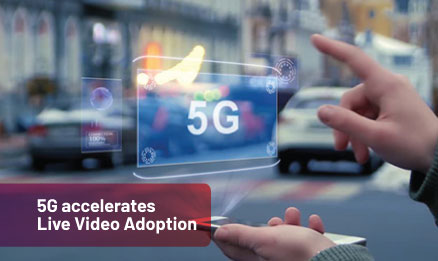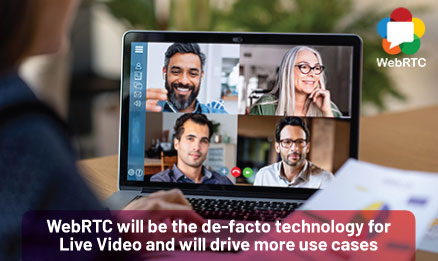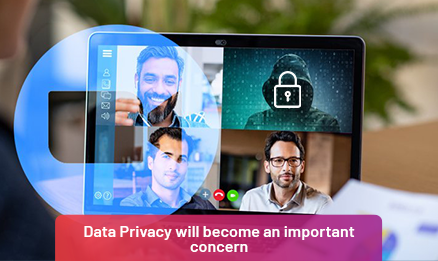Video is the next normal. The pandemic has hyper-accelerated the digitalisation and adoption of Live Video. More than ever, enterprises and governments are using Live Video as the ultimate solution to communicate with remote workers, customers & partners. Even small business owners like fitness instructors, therapists, music teachers, etc. have turned to video calling to connect with their customers. These fast-emerging virtual video interactions have pushed and motivated even the least technologically inclined, including the elderly, to adopt and embrace this new normal.
Soon, Video will overtake Voice to be the number one communication channel. The market is increasingly witnessing new entrances of video conferencing vendors as well as Communications Platform-as-a-Service (CPaaS) providers who are realigning their offerings to include Video API.
2021 will be the year of Video and here’s why:
5G accelerates Live Video Adoption
The high network speed, reliable connections and increased bandwidth that 5G will bring to the market will drive innovation across all communications. Among them, video call improvements from 5G will be the most substantial. With 5G boosting network speed of more than 20x faster than the current 4G standard, glitchy video calls and freezing video will be a thing of the past.
Beyond quality, 5G will radically change how brands could engage with their customers. Companies can revolutionise customer experience by offering real-time personalised and predictive engagement. A salesperson will have real-time actionable insights about a shopper’s behaviour and preference once he/she enters the store. This allows the salesperson to create a rich, tailored shopping experience. Healthcare could also benefit from possibilities such as remote patient monitoring through Live Video, image transfer AR/VR-enabled healthcare, ingestible Drone-enabled medical service delivery and more. On the education front, 5G will also prove to be the next-generation tech for next-generation Edtech since distance learning, online education will become more accessible, convenient and a lot better.
We believe many innovative businesses will tap on this “next wave of speed” to create new immersive experiences by overlaying video calls with Virtual and Augmented Reality, 3D imaging, holographic calls, gamification and more. The possibilities are endless.
WebRTC will be the de-facto technology for Live Video and will drive more use cases
WebRTC is now the go-to technology for developers to easily build real-time communication capabilities in their browsers and applications. It’s fast becoming a fundamental part of the foundation supporting modern communications, especially Live Video. The support of WebRTC across browsers, its interoperability with UC and VOIP services, and its simplicity to integrate voice and video within an application have boosted the widespread adoption of WebRTC.
Furthermore, the webification of communication systems and changes in consumer expectation to communicate seamlessly on any device and channel have resulted in many analysts projecting an exponential growth rate for WebRTC as a technology. According to Research and Marketing, WebRTC projects a CAGR of 41.7% (from 2020 to 2027).
The next few years with WebRTC will be about innovations and finding new opportunities and use cases. It will emerge as the technology behind video communication. Its usage will go beyond customer-agent communication for contact centre, teacher-student engagement for online learning and patient-doctor consultation in the healthcare industry.
New use cases will emerge, such as communications for autonomous vehicles and Smart Cities. Self-driving cars require a tremendous amount of data and processing power. A car communicates with other vehicles and the outside world to determine its location, speed and objects around. This is where WebRTC helps power the machine vision by enabling information exchange through data transfers, audio and video. In the same manner, IoT devices can be connected with WebRTC. Messages and Live videos can be sent from IoT devices like Bluetooth trackers or smart security cameras to keep users connected to their items.
Advanced in AI & ML will Improve Video quality and experience
With video-based communication becoming the new normal, the coming years will have an influx of new vendors and CPaaS providers. With consumer expectations soaring high, coupled with fierce competition, video quality and overall experience will be the key differentiator when offering Live Video.
Artificial intelligence (AI) & Machine Learning (ML) in real-time communications can enhance video quality. Noise suppression, resolution improvement, bandwidth estimation, packet loss concealment have the potential to refine video communications and improve the user experience. For example, AWS has added Noise Suppression to Chimes, and Apple uses Machine Learning algorithms to detect and suppress loud noises to separate conversation from the background.
Some vendors have also used Computer Vision and AI to automatically detect visual issues, adjust unstable cameras, optimise light balance and improvise attendee’s background environment to enhance video quality.
AI could also be used to create high-quality versions of low-resolution images. Algorithms could be used to transmit lower quality video from the sender, which is then regenerated to a higher quality video at the receiver.
Currently, CPaaS is utilised by many businesses to rapidly scale real-time communications capabilities. But in 2021, we expect to see CPaaS evolve further, with more extensive use of AI and other data science technologies to pave the way for a hyper-personalised customer experience.
Video will be the key channel in Customer Engagement
Video interactions are expected to grow, driven partly by the pandemic but mostly by the success that companies have gained from using it. In fact, many organisations have witnessed that video-enabled customer engagement can lead to demonstrable improvements in business outcomes.
Healthcare, especially during COVID-19, have used video chat to connect with physicians, nurses, pharmacists and patients. And virtual agents, in the form of healthcare experts, are using video calls for remote diagnosis. On the other hand, the retailers are innovating with video calls and AR/VR for a virtual walkthrough of their products with the customers. Organisations are also enabling video capabilities within their contact centre solutions to provide a richer experience to customers. Those facing challenges while installing or assembling products can use video to get live customer support easily.
Video delivers a superior & more personalised experience for service providers & users alike. It decreases resolution time and increases customer satisfaction, thus driving higher ROI & greater levels of customer service. We believe in the year 2021, video will emerge as the preferred channel of customer engagement.
Data Privacy will become an important concern
The growth in live video will also raise concerns towards data privacy and in-country regulations. For general communication needs, routing sensitive video and audio data over global networks is doable, but for sensitive communications with government organisations or sectors such as healthcare & banking, improving in-country internet architecture and in-country data hosting will become crucial. Cloud-based video solutions will still be used because of their ability to scale on demand, but countries and enterprises will be investing more on in-country hosting and data security. The local vendors and system integrators who have a deeper understanding of the respective market will help address this growing need.
Definition
- CPaaS – Communications Platform as a Service (CPaaS) is a cloud-based delivery model that lets you add voice, video, and messaging features to your existing business software using APIs. With CPaaS, you can fully customise your communication stack. Instead of buying complete solutions with predefined features, you can integrate selected communication channels with the software you already use.
- WebRTC – Web Real-time Communications (WebRTC) is an open-source project created by Google to enable peer-to-peer communication (audio, video and data transfer) in the web browser through application programming interfaces (APIs). It eliminates the need for plugins and native app installations to make peer-to-peer communication user and developer-friendly.







